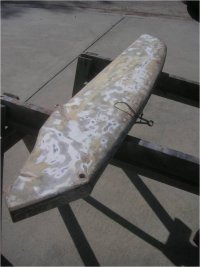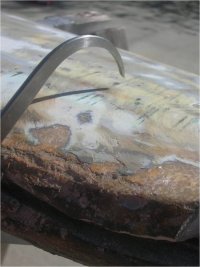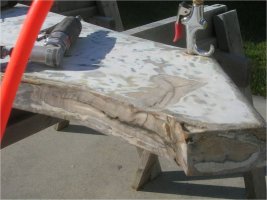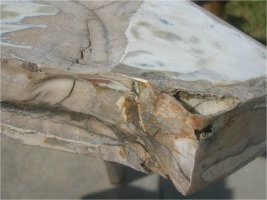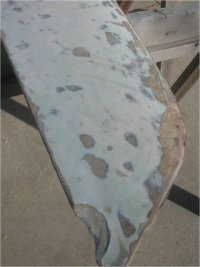davisr
Member III
Just thought I send along some pictures of the progress my buddy and I have made on my centerboard. Didn't get to the glass today. Spent a couple of hours taking off the last remnants of bottom paint and grinding out some of the problem areas. Turned out to be a good idea to take that bottom paint off. It revealed some other areas that needed attention. One of the most interesting discoveries I made with the calipers was that the thickest part of the board is located about 17 inches down from the eyelet. At that point, it is 2 5/8 inches thick. Taking the calipers and running them down the board it is easy to see that the board slowly narrows as it nears the bottom. It loses about 3/8 inch in the drop. This makes me think that it was in fact the thick layers of bottom paint -- especially the gooped up half-dried layers near the mid section -- that had caused the board to become stuck some two years ago after the last bottom paint job.
With the many layers now gone, the hydrodynamic qualities of the board (that are touted in the old E25 promotional material) are evident. Lots of nice curves.
Have stored the board indoors ever since I bought the boat in October. Will let the board now sit a little longer in a heated work room until after Thanksgiving. Want to make sure every bit of moisture has a chance to evaporate.
Best,
Roscoe
Attached are five pictures of the progress.
001: Calipers at thickest part of board; greenish color on board is old layer of resin that was put on top of the gel-coat (white) during some repair in the past
002: space of 3/8 inches between caliper and board; thinner here than at mid-point of board
003: more cracks revealed as a result of removing bottom paint; someone made a half-way effort at repairing it in the past before covering it with bottom paint
004: detail
005: aft blade of board ground down for the repair of damage done by boatyard worker with crowbar while removing board during haulout
With the many layers now gone, the hydrodynamic qualities of the board (that are touted in the old E25 promotional material) are evident. Lots of nice curves.
Have stored the board indoors ever since I bought the boat in October. Will let the board now sit a little longer in a heated work room until after Thanksgiving. Want to make sure every bit of moisture has a chance to evaporate.
Best,
Roscoe
Attached are five pictures of the progress.
001: Calipers at thickest part of board; greenish color on board is old layer of resin that was put on top of the gel-coat (white) during some repair in the past
002: space of 3/8 inches between caliper and board; thinner here than at mid-point of board
003: more cracks revealed as a result of removing bottom paint; someone made a half-way effort at repairing it in the past before covering it with bottom paint
004: detail
005: aft blade of board ground down for the repair of damage done by boatyard worker with crowbar while removing board during haulout


